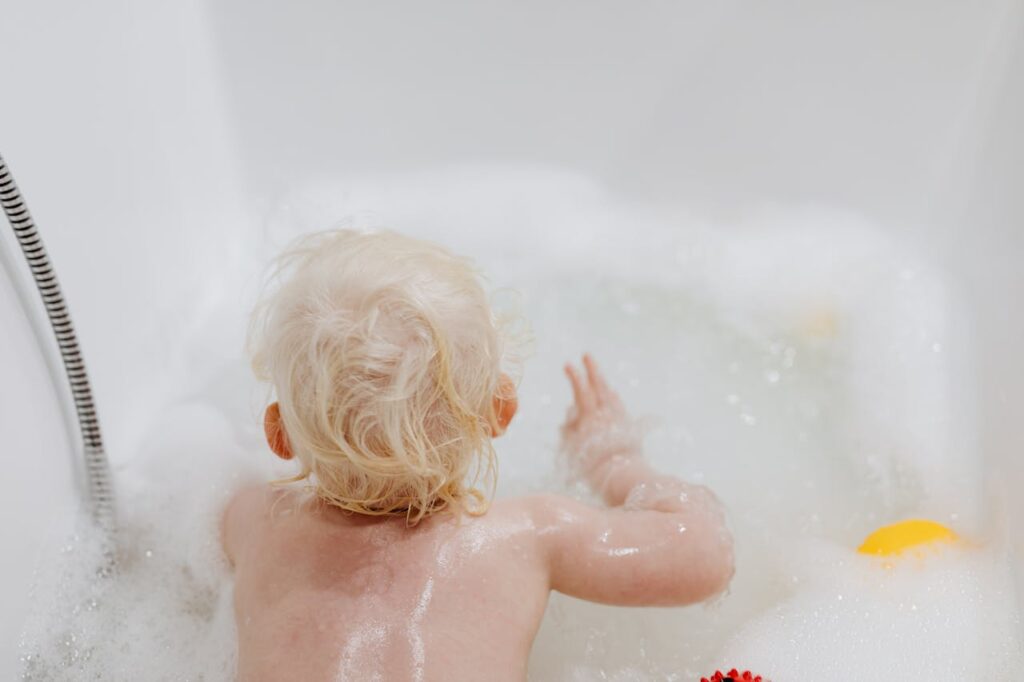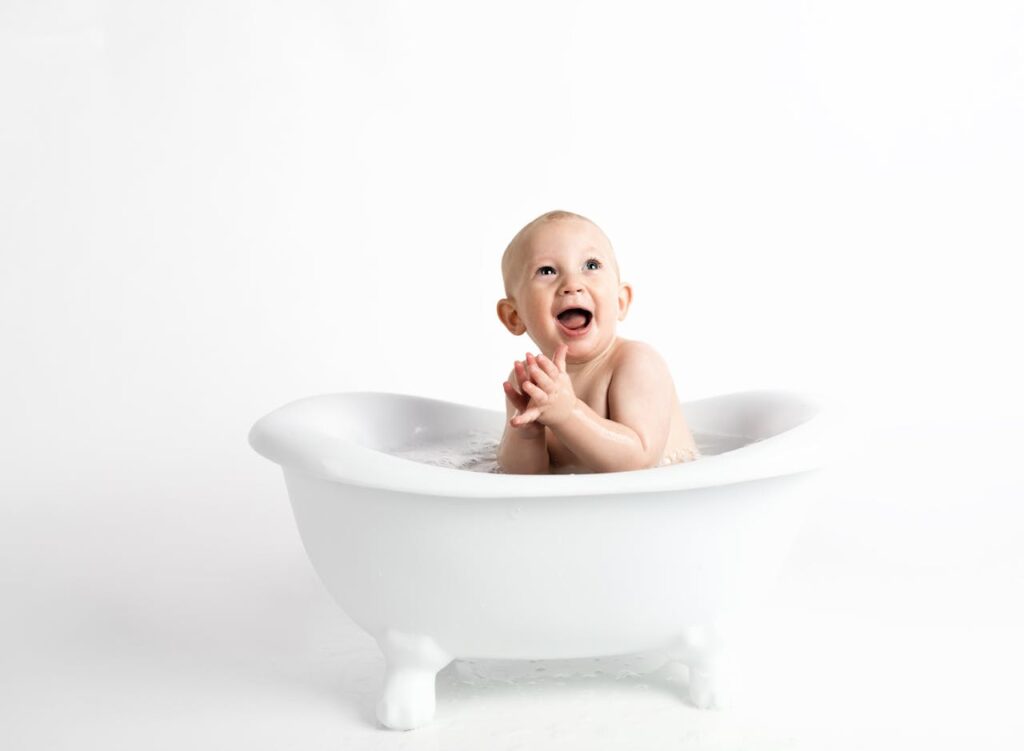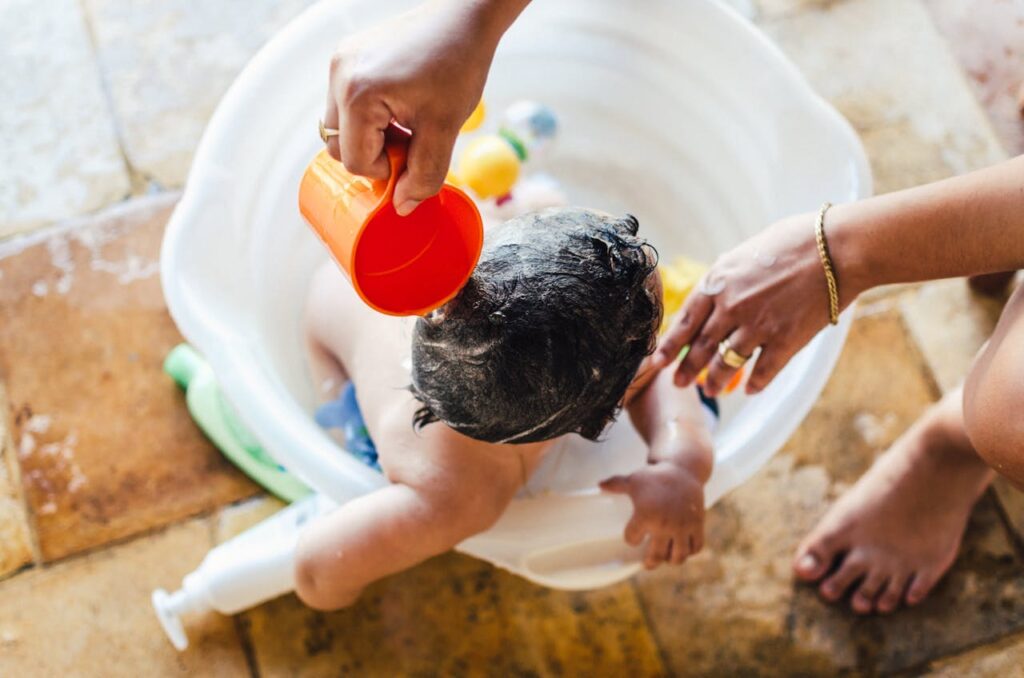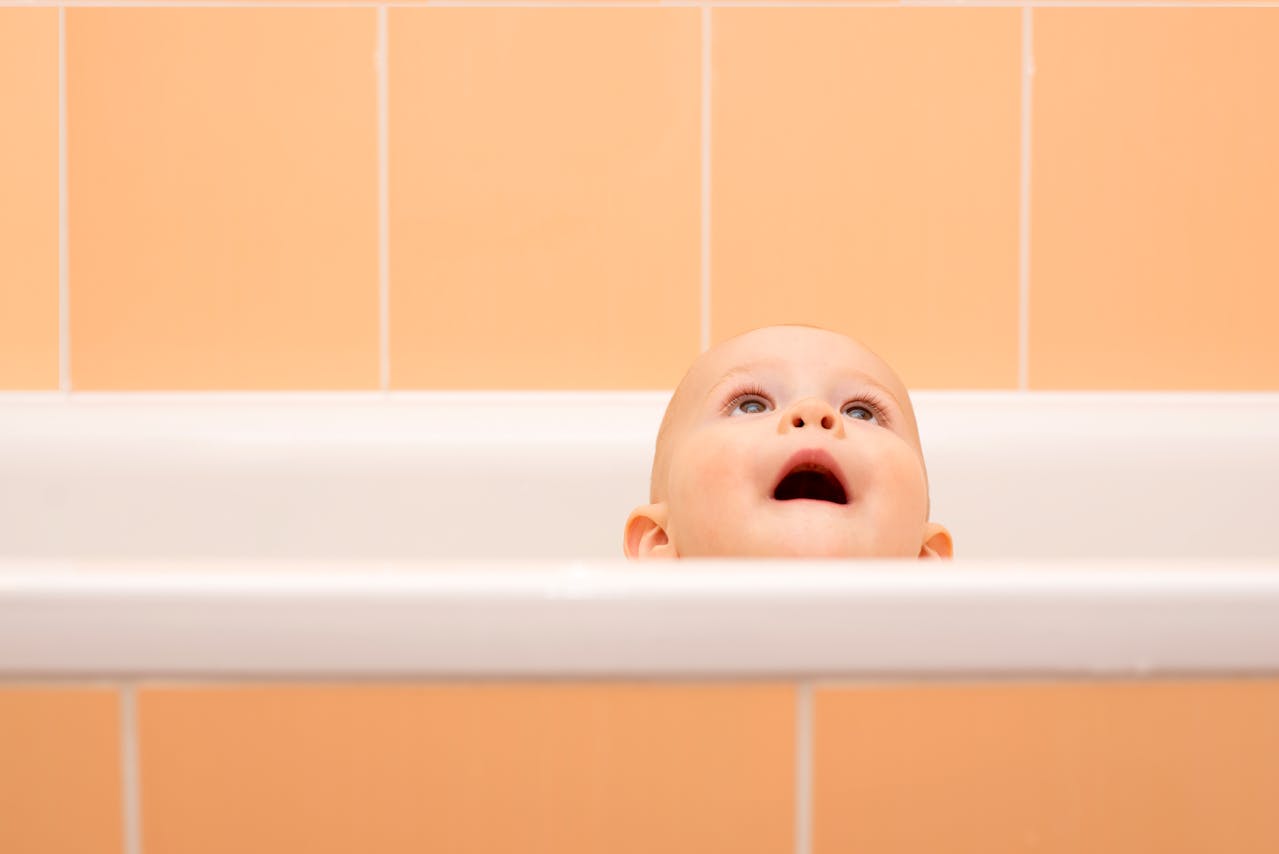Some children love the water and any chance to play in it. Some are always fussy around bathtime. But what do you do when your toddler suddenly hates baths and fights you all the way to the tub? Screaming, standing, crying, complete meltdowns: these are all common responses when a toddler suddenly turns against bathtime. But they still have to get clean.
Parents struggling with a toddler afraid of baths should rest assured that this sudden change is quite normal. Most parents go through some version of the Battle of the Bath. Children between 1 and 4 are going through a lot of changes, and this can include their attitude about perfectly normal things that they enjoyed last week. Fortunately, you are not alone. We can help you face the emotional and practical challengs as you wonder “Why does my toddler hate baths all of the sudden?”.
Let’s explore the possible reasons, solutions, and how to make it through this challenging phase.
Understanding Why Your Toddler Suddenly Hates Baths
From 18 months old to pre-schoolers, a toddler may suddenly revolt against bathtime, and there are many possible reasons. When your toddler suddenly hates baths, they may dislike the feeling of water temperature or they might be reacting to a previous bad experience. You may notice your toddler afraid of the bath when they weren’t before, or they might be exercising independence against their bedtime routine.
Developmental changes can have a strong influence on what a toddler does or does not want to do, from new interests to new fears. It’s important to be patient with your child and explore why your toddler suddenly hates baths to find your way to the solution.

Credit: Pexels
Developmental Changes in Toddlers
Toddlers are passing many developmental milestones, from independence to cognitive growth that can lead to new fears and anxieties. Your toddler’s reaction to bath time may change because they are changing mentally and emotionally.
Imagination, perception, and childlike/magical thinking can lead to fears that might not even make sense. But when a 2-year-old or 3-year-old suddenly hates baths, they may be going through a mental and emotional journey that you’ll need to explore to help them through.
Being In Charge
We all know that toddlers sometimes say no just to feel in charge. If you are asking “why does my toddler hate baths?” when they loved baths recently, this could be this month’s thing to say “No” to.
Toddlers are learning how to be in charge of themselves, while also constantly testing the world around them. Sometimes, saying no is a way to test those boundaries, and can even be a display of their trust in you to test when you are the one in charge. Self-Determination Theory suggests giving your toddlers alternative decisions to make, other than simply agreeing or refusing to go along with the status quo.
Fighting Bedtime
As toddlers get older, they gain the ability to stay up longer, even if they get cranky doing it. When a 3-year-old suddenly hates baths, it might be because “bath time” is associated with “bedtime.” If they put away their toys and have a bath, pajamas and lights-out are soon to come after. Your toddler may be taking a stand against bath time because they don’t want to go to bed yet. While this battle might lead to a bedtime meltdown, it’s also perfectly normal as your toddler matures.
New Found Fears and Phobias
It is not unusual for small children to develop new childhood fears that weren’t there before. A child whose imagination is growing may suddenly fear the dark, the attic, a specific toy, and – yes – even fear of the bath. Children might fear that they’ll wash down the drain, or that something will crawl up. They might suddenly fear the feeling of floating or what lurks below the bubbles. It doesn’t have to make sense to an adult to be a real fear for your child.
Changes in Routine or Environment
Consider how big each and every experience is for a toddler. Changes and negative experiences can have a big impact on a toddler and their feelings about bath time. A new house, a new care giver, a new big tub, or even new bath toys can cause a mental change that turns into strong objections.
Let’s not forget that children often strongly remember recent negative experiences.
The Impact of a Recent Negative Experience
When a toddler suddenly hates baths, they might have connected a previous unpleasant experience with the possibility that it could happen again. Even something as passing (for adults) as getting water in their eyes or bumping into the faucet. A slip, a splash, a single scared moment can cause a toddler to suddenly fear bath time. If it happened last week, you may have forgotten. But your toddler hasn’t.
Sensory Sensitivities
Toddlers are often very sensitive, especially to water temperature or the texture of bath products. If a toddler associates too-hot or too-cold water with the bath or decides they hate their shampoo, you might wind up with a fight or crying objections at bath time. Bubble bath might be the answer, or it might be the problem. It’s important to explore and find out.
The Role of Water Temperature and Bath Products
Water temperature is very important for small children. A toddler afraid of bath time may have been burned or frozen just once and never want to feel that again. Finding the right bath products is also important. A toddler may decide that a soap is too slippy or slimy, or too gritty and scrubby. And just one soapy hand in the eye can cause an unpleasant sensation they’ll try to avoid in the future. When your toddler suddenly hates baths, ask them about the sensations they associate with bathtime.

Credit: Pexels
Strategies for Reintroducing Bath Time When Your Toddler Hates Baths
“How do I get my toddler to like baths again?” This is a common question asked by parents of children 1-4 years old when the bathtime rebellion occurs.
When your 3 year old suddenly hates baths or you have a toddler afraid of baths they loved last month, what can you do? The good news is that most toddlers overcome their aversion to baths in a fairly short time if they apply the right techniques. Rather than simply being forceful, you can help your child rebuild positive associations with the bath and ensure future baths don’t give then new reasons to revolt.
1. Create a Fun and Positive Bath Time Experience
First, make bath time fun and enjoyable. Don’t fall into the “sitcom” trap of baths being an “awww, man” experience. Baths are a bonding opportunity with your toddler. A time to talk together, practice self-care, and build happy memories. Make love, attention, and fun the core focus of bath time – in addition to getting clean.
- Play bath games, like “bubble cafe” or “pirate ship” to make baths a special play time.
- Include your child’s favorite bath toys, or cycle in new bath toys each month to keep it interesting.
- Read water-themed stories during bath time.
- Ask your toddler about their day, imagine dreams to have at bedtime, or make up stories together.
- Try bath crayons and tub stickers.
The key is to make bath time a more appealing experience for your toddler. At the same time, carefully reduce the risk of negative experiences like using a visor during hair washing or a wash cloth for gentle non-scratchy cleaning.
In some cases, it can help to get in the tub with your toddler and reintroduce snuggles or splashing together. This can make bath time feel both safer and more personal, especially if your toddler suddenly hates baths because of a fear or feels isolated in the big bath tub.

Credit: Pexels
2. Gradual Reintroduction Techniques
Gradual reintroduction is the best way to help a fearful or reluctant toddler afraid of bath time. A new bath time fear can be conquered by taking baths in a new way and slowly reintroducing traditional bath time experiences. There are many paths you can take when your toddler suddenly hates baths to help them feel more in-control, safe, and confident in the bathtub.
- If your child is afraid of deeper water or the drain, consider putting only a small amount of water in the tub and giving your child a washcloth bath.
- Slowly introduce deeper water.
- Pour water into the bath so your toddler can experience the sensation of the water rising.
- Go back to the bath chair, or remove the bath chair depending on how your toddler feels.
- Introduce choice and ask your toddler as you reintroduce water depth, temperature changes, or risky activities like hair washing to the bath.
You can also adapt the reintroduction method based on your child’s specific reactions or fears. Using the Self-Determination Theory for positive parenting, you can address your child’s specific objections to the bath, whether they are rooted in a new phobia, a bad experience, or even the simple desire to say “no” and feel in charge.
- If your child wary of hot or cold water, work together to test the water until it’s “just right”. You can use a tub thermometer to help you get the water “just right” every time in the future. Remember: Adults almost always like hotter bathing water than small children.
- Use praise and positive reinforcement to encourage confidence in your child using Self-Determination Theory. Encourage your toddler to embrace bathtime bravely again.
- Let your child make decisions by giving them options. This toy or that toy? Hotter or colder? A little more water, or open the drain for a few seconds? Wash arms or legs first? This gives them a sense of autonomy and control over the bath.
- Address your child’s fears. Acknowledge the fear and then talk it out.
- Teach your toddler hydrodynamics. Play with the sink drain (and toys too big to go down) to show them that drains aren’t scary.
- Introduce showers as an option if your toddler doesn’t want to sit for baths anymore.
3. Address Sensory Issues
Some children have sensory issues that impact their experience of bath time. Talk to your child about how they feel about the bath temperature, sensations on their skin, or the feeling of floating in deper water that might be bothering them.
Choose a gentle bath temperature and look for extremely mild toddler-friendly bath products. Warm water and a small exploration of soap, shampoo, and bubble-bath options can help a toddler with sensory objections find the bath experience they like best.
When To Seek Professional Help
Of course, there are a few situations where a sudden aversion to baths is more serious. A child who becomes suddenly highly sensitive to warm or cold water may need to visit the pediatrician. It could be an indication of a rash or illness that increases their skin sensitivity. If your child develops an overwhelming phobia or a fear-fantasy that frightens adults, it is reasonable to consult with a child psychologist. You can also seek professional help if the bath aversion persists over the past few months despite your best efforts.
A little fussiness or a passing phase is normal. But more serious conditions and long-term aversions can be assisted with the help of child health professionals. Professional intervention can help you solve the mystery and help your child become comfortable with bathing again.
Conclusion
If you are in the middle of The Battle of the Bath, know that you are not alone. Many toddlers go through this phase, and it usually passes in a few days, weeks, or months. When your toddler suddenly hates baths, the key is to find the cause and gently guide your toddler back to normal understanding and feelings about the bath. Remember that your child’s fears, worries, and even their desire to be in control are valid feelings. You probably don’t remember your own bathtime revolt, but there’s a good chance your parents went through this, too.
You can make it through this phase with patience, empathy, and creativity. With the right strategies, most parents can help their toddlers overcome their bath time aversions and enjoy the bath with renewed enthusiasm. Use these tips and your own innovative solutions for a smooth return to relaxed bath time experiences. Good luck!
Ready to help your child conquer their bath time fears? Join one of our parenting classes to learn expert strategies and techniques designed for both parents and caregivers. Sign up now to make bath time a fun and stress-free experience for you and your child!
Having a hard time with your baby’s bath routine? Ask Sophie, our AI Parenting Expert, any questions you have about baby bath challenges and get instant, helpful advice!
References
Amy M. Kolak, Tara J. Frey, Chloe A. Brown & Lynne Vernon-Feagans (2013) Minor Illnesses, Temperament, and Toddler Social Functioning, Early Education and Development, 24:8, 1232-1244, https://doi.org/10.1080/10409289.2013.764224
Bezdek, G.K & Telzer, H. E. (2017, December 20th). Have No Fear, the Brain is Here! How Your Brain Responds to Stress. Frontiers. https://kids.frontiersin.org/articles/10.3389/frym.2017.00071
National Scientific Council on the Developing Child. (2005/2014). Excessive Stress Disrupts the Architecture of the Developing Brain: Working Paper 3. Updated Edition. http://www.developingchild.harvard.edu
Williams, R. (2017). Anger as a Basic Emotion and Its Role in Personality Building and Pathological Growth: The Neuroscientific, Developmental and Clinical Perspectives. Frontiers in Psychology, 8. https://doi.org/10.3389/fpsyg.2017.01950









